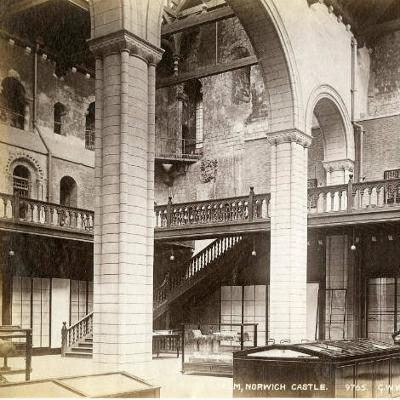Norwich Castle: 950 Years of History

1067
William I (William the Conqueror) orders over 98 Saxon homes to be demolished, with tall castle earthworks and deep defensive ditches built in their place.
1075
A wooden motte-and-bailey castle withstands a rebel siege attempt.
1094
Work begins on the stone keep you see today, overseen by William (Rufus) II. This includes much larger earthworks to support its huge weight. Limestone is shipped from Caen in France at a cost of over three times the original value of the stone!
1100
William II dies, and work on the stone keep is continued by his brother, Henry I.
1121
The stone keep is completed. It was intended as a royal palace, not a fortified stronghold. Henry I is thought to have stayed at the Castle during a crown wearing ceremony at Christmas.
1121-1300s
The Castle and its keep serve as a royal residence as well as a centre for legal and financial rule over the region.
1345
The Castle's role as a legal centre takes over, and it is used as a prison for around 500 years, until the end of the 19th century.
1792-3
A new cell block designed by renowned architect, Sir John Soane, is built within the Keep. The Norman keep is just an empty roofless shell.
1822-8
The gaol is remodelled by local architect William Wilkins, following the latest thinking on prison design. The cell blocks are arranged like spokes of a wheel, with the gaoler's house in the centre overlooking the whole prison.
1834-9
The keep is completely refaced with bright Bath stone, replacing the flint facing on the lower part. Architect Anthony Salvin faithfully recreates the original ornate arcading which makes Norwich Castle such a spectacular example of Romanesque architecture.
1884
Plans are approved for a new prison at Mousehold Heath on the outskirts of Norwich.
1885-6
John Gurney, Mayor of Norwich, donates £5000 to help move the Norfolk & Norwich Museum from St Andrew's Street to the Castle.
1888
Architect Edward Boardman submits his plans for converting the gaol to a museum. Excavation and building work begins
1894
The museum is opened on 23 October by the Duke and Duchess of York, later King George V and Queen Mary.
1950
A large development programme sees the construction of two new art galleries.
1969
The central Rotunda is introduced with the infilling of an open courtyard and garden to unify the museum and provide new facilities.
1999-2001
A major repair and improvement programme is undertaken by Purcell Miller Tritton. The museum is formally re-opened by Queen Elizabeth II.
2016
Major support is given by the Heritage Lottery Fund to return the keep to its medieval form and create new visitor facilities within the Castle.
2017
New designs show how the Castle Keep, reception, café and shop will be transformed.
2018-19
Archaeological excavations and surveys uncover more about the medieval foundations.
2020
Work begins on site to restore the Castle Keep to its former medieval glory.
